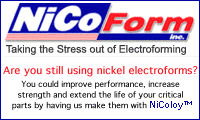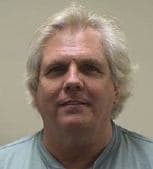
-----
Spot-Free Drying of Parts
Q. Would someone please provide me information on chemical solutions which will dry without leaving any solid residue on a part. Ideally this would be a chemical that is added to a water rinse and does not have any toxic effects and/or bi-products. I am trying to get rinse water to "sheet" off without leaving any 'water stains' on the part. Thank You.
Kevin Fleury- Springfield, Massachusetts
1998
A. A few years ago this would have been a chip shot. The same vapor degreasing chemicals and equipment that are used for cleaning will do exactly what you are seeking: displace the water, then leave a stain-free surface. There are still some vapor degreasing solvents that are not ozone destroying, but they are very expensive. Unless your need is for perfection, I think high quality deionized water should do the job though.

Ted Mooney, P.E.
Striving to live Aloha
finishing.com - Pine Beach, New Jersey
|
A. Isopropyl/methyl alcohol or acetone ⇦ on eBay or Amazon [affil links] Warning! Flammable! will do what you want if a safe dip-tank process could be set up. However it is expensive because these will get saturated with water quickly and recycling will be required often. I have seen acetone vapor degreasers, these would be safe. Mandar Sunthankar- Fort Collins, Colorado Ed. note: Note the "if" in Mandar's response; acetone is flammable. A. Steps that will help.
It all depends how spot free you need. There is no free lunch on this one. James Watts- Navarre, Florida A. Kevin 3M makes a "spot-free" drying agent of perfluoro-N-methyl morpholine that might be useful. Also it is common to add about 50% alcohol to water to lower its surface tension and aid in drying. Donald M. MattoxSociety of Vacuum Coaters Albuquerque, New Mexico
Donald is the author of:
"Handbook of Physical Vapor Deposition (PVD) Processing" (2010) [on AbeBooks or eBay or Amazon affil links] and "The Foundations of Vacuum Coating Technology" (2018) on AbeBooks or eBay or Amazon affil links] |
A. I agree with and have heard of all the other technologies mentioned above. My comment is that without a little more clarification this seems like a how-clean-is-clean? question.
There are many wetting agent type anti-spotting products on the market for final rinse stages. They all work pretty good, but as stated above the degree of spotting tendencies and the drying equation are affected by rinse temperature and water quality. Parts will dry faster and have reduced chances of incurring spots of the water runs off quickly and if it has fewer minerals in it to begin with.
The main part of the how-spot-free-is-spot-free? question is what is the subsequent processing of the part that requires the part to be spot free and what degree of residue is tolerable by that process.
My suggestion: R/O water hot 140-160 °F, with a surfactant-type surface tension reducer/spot reducer/rinse-aid or the fluorinated rinse additives and alcohol as suggested above.

Craig Burkart
- Naperville, Illinois
A. Some people will tumble the finished parts in sawdust, corn meal, wood chips, etc. Very cheap and sometimes quite effective in not only getting the parts dry but also removing any drying stains that hard water or incomplete rinsing would normally cause.

"PlaterB" Berl Stein
NiCoForm, Inc.
Rochester, New York

Multiple threads merged: please forgive chronology errors and repetition 🙂
Q. I am looking for a way of drying brass and other parts spot free. Can anyone give me suggestions on how to do that in high volume production of complex parts?
Bob Dykhouse1998
A. At least two rinses after plate counter flowed with DI water with the last rinse around 140 °F. Possibly adding a wetting agent from your favorite supplier. I have used a warm mixture on isopropyl and water for a final rinse (not counter flowed).
James Watts- Navarre, Florida
A. There are two ways I can think of immediately, and James has mentioned one of them: DI water.
The other way is to use a vapor degreaser as a dryer -- but considering the anti-smog rules and the anti-CFC rules, I'm not sure what would be the most appropriate solvent for spot-free drying in your particular case.

Ted Mooney, P.E.
Striving to live Aloha
finishing.com - Pine Beach, New Jersey
A. Hi,
Drying with spots could be a function of drying with "something" left on the part. It might be incomplete soil removal (especially with buffing compounds), rinse water hardness, or incomplete rinsing.It could also be a function of the way the parts are racked
1) take a part clean it rinse it and manually dry it
2) take a part clean it manually rinse it and manually dry it
3) Rinse with DI water, city water
4) Dry with air and with IPA
This should provide you with an idea where the spots are coming from. Let me know what you find out and I will be more than happy to direct you from there.
p.s. there are drying solvents that are non ODC if you need to go that route.
Have fun.
Dan ZinmanA. Watermarks are common on DI rinsed materials.I would like to know the size of the pieces that you are drying.
If they are about 14~15" diameter, you could do IPA vapor drying. IPA vapor dryers are most commonly used in semiconductor wafer drying after the DI water rinsing.
IPA vapor dryers dry components without watermarks; no particles are added.
Regards,
Mehmet Delikanlioglu- Fort Worth, Texas
Q. I do not disagree with you, Mehmet. I know that even in certain electroplating for electronics situations it is necessary to use a solvent dryer rather than just DI water.
What I don't understand, and maybe you or Dan can enlighten me, is why? It is possible to generate ultra-high purity water (12 megohm, I think they call it) which probably doesn't have a grain of salt in an ocean full. How could this possibly leave even the faintest whisper of a salt stain? Or is the problem that ultra high purity water will corrode the finish?

Ted Mooney, P.E.
Striving to live Aloha
finishing.com - Pine Beach, New Jersey
A. Ted, that is an interesting question. Is it because the water may leave the tap at 12 megohm, but the parts are not rinsed by 12 megohm water? Maybe top sprays of the high purity water would do the best job.

Tom Pullizzi
Falls Township, Pennsylvania
A. Here are my two bits. I have worked in the wafer fab and have rinsed wafers with 16 megohm water. The moment the water touches air and wafers, the resistivity goes down, and you have to rinse parts for at least 10 minutes to get the resistivity to about 10 megohms. Another rule of thumb in the fab, minimize the dissolution of air in water because it forms carbonic acid. So showers are out. Only three-cascade rinse is commonly used, and you move the wafers from lower cascade to upper cascade. It may also be necessary to blow the water out with hot dryer as fast as possible.
Now, if you do not have a clean room, or HEPA filtered hood with the wet-bench, I do not know what could happen. The showers are likely to carry dust and contaminants from the air and deposit on the parts. Also, the DI water with high resistivity is known to corrode certain metals. So that hypothesis could be looked into.
Mandar.
Mandar Sunthankar- Fort Collins, Colorado
A. Dear Bob,
Generally (DI) water is your best bet. However there are different (DI) water qualities. To justify this is as follows; Most of the dissolved impurities in city water supplies are ions such as Calcium, Sodium, Chlorides, etc. These can all be of the salt nature and will be different from city to city and/or region to region. Deionization occurs when this water is pressured through a resin bed. The pressure must be adequate for the water to be evenly pushed through the resin tank or the water will take the path of least resistance. This is called channeling.
There are different resin qualities that can be used which will affect the quality of water you are testing. Also you can use a mixed bed or a two bed system to makeup (DI) water. A two bed system will make water faster and a mixed bed will make water purer. Mixed beds are much more difficult to clean because you must separate the cations and the anions before you can strip the ions free. So, water quality varies with the type of resins used, feed water quality, flow variations, efficiency of regeneration, remaining capacity. This is why you must know the precise quality you need before you buy the equipment.
Mandar is quite correct when he stated that as soon as the (DI) water hits air, it starts to pick up carbonic acid. These are some reasons to look at why there may be enough TDS for spotting. Read my answer on Rinse Water Criteria thread 1340 for further discussion. Need more help? Let me know.
 Bob Utech Benson, Minnesota |
 Ed. note: Bob is the author of: "High Performance powder Coating" on eBay or AbeBooks or Amazon [affil links] |
A. Just a note: Carbonic acid is formed when carbon dioxide from the air is absorbed or dissolved in water, same as in the case of soda water.
Mandar.
Mandar Sunthankar- Fort Collins, Colorado
A. It does not matter how pure is your DI water, that will leave water marks if it is naturally dried on your product. I do not know if you ever tried other drying systems but you have only one solution is to use IPA vapor dryers. IPA vapor diffuses on your product and runs the DI water until surface tension comes to natural equilibrium then you will have no water marks. This process will also removes some particles too.
Best regards,
Mehmet Delikanlioglu [returning]- Fort Worth, Texas
A. The cleanliness of DI water is only one part of the drying equation. Even having very pure DI water (18 Mohm-cm) does not guarantee the part cleanliness. The amount of drag-out, air quality and water removal from part will all have significant impact on the stain formation. IPA and other solvent dryers have a significant advantage over simple DI water rinse and drying since they displace the remaining water (carrying soluble contamination). After solvent evaporates, there is no residual contaminant left to form stain. Otherwise the water removal mechanism is equally as important as the DI water quality itself.
Paul Silinger- Spokane, Washington
March 13, 2012
Q. We are wet blasting 300 series stainless steel metal pressings through a automated system where the parts are carried on a fixtures through a series of pre-cleaning sprays and spray rinsing.
The wet blasting process is a slurry of abrasive with additions of citric acid
⇦ on
eBay
or
Amazon [affil links] and other magic additives. Following blasting the parts are rinsed in a three stage spray with a final rinse of RO water with conductive below 10. The parts are then blown off with air from a oil free blower.
Our problem is he part is a medical component and the slightest water mark or staining is unacceptable.
The surface being freshly blasted and blow dried with hot air seems produce a surface that's made to stain.
Having tried many things without much success I am starting to have crazy thoughts of trying to dry the parts by blowing "corn grit" at the product through a recycled and heat system.
I know corn grit drying is commonly used in the mass finishing industry in vibrators, never heard of someone blowing corn grit at a product.
Any words of wisdom from the finishing world would be appreciated.
Technical manager - Sydney Australia
February 25, 2014
A. Garry, There can be a few different reasons for this to happen.
Perhaps you're not getting the part clean. You can't really produce a water-break free surface on stainless so that test method isn't valid.
You need to make sure the wash/rinse is cleaning you slurry and special pixy dust off the parts. If not, it will show up as defects.
Although your 10 micromhos is probably fine, this reading of 10 micromhos may be erroneous because the TDS readings only take into consideration anything in the solution that can be conductive and if there's anything else in the solution that's not conductive it won't show up as a TDS result, be will show up on your part.
Generally the conductivity of a solution increases with temperature as the mobility of the ions increases.
I think your blow off is probably fine also as long as it's not too hot which would dry any solution hardness onto the part and as long as the air is filtered.
I would try using your process on a piece of cold rolled and see if it can achieve your goals first. See if it passes the water break free test. It may give you some idea where this issue is starting.
 Bob Utech Benson, Minnesota |
 Ed. note: Bob is the author of: "High Performance powder Coating" on eBay or AbeBooks or Amazon [affil links] |
Q. Bob
Thanks for your comments.
Our slurry blasted components are very clean before our drying stage and are certainly water-break free.
I believe that we are getting a reaction between the water regardless of DI or RO and the fresh surface.
We are blowing off with warm air, due to the heating action of the blowers, which is not going to help this problem.
The use of solvent drying systems may well be the answer but with components at about 300 in Dia. (or should I say 12 inches) coming off the line every 20 seconds it makes for a rather complex solvent drying plant.
My question was "does anyone think we could dry parts by mechanical by blasting them with dry corn cob or some other absorbent material?"
- Sydney NSW Australia
February 27, 2014
A. Hi Garry. Yes, earlier in the thread to which we appended your inquiry, Berl Stein suggests that. Good luck.
Regards,

Ted Mooney, P.E.
Striving to live Aloha
finishing.com - Pine Beach, New Jersey
Q, A, or Comment on THIS thread -or- Start a NEW Thread
